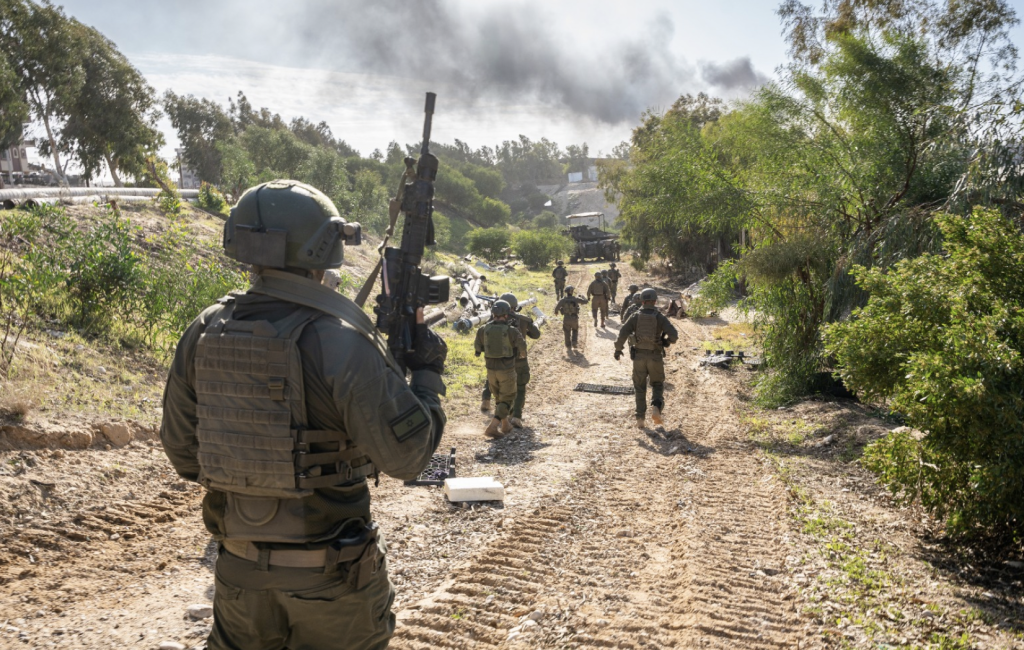
A key priority for Israel in the wake of October 7 has been re-establishing security along its border with Gaza. When Hezbollah began attacks against Israel on October 8, the issue of border security in the north was also thrust upon the Israelis. As a result, Israel evacuated communities along its borders with both Gaza and Lebanon. Now four months into the conflict, Israel is seeking to alter long-term security on both fronts. In the north, Israel says it is seeking a diplomatic solution that would see Hezbollah withdraw its forces from the border. In Gaza, the dismantling of threats has been underway since late October.
The January 22 detonation of munitions which caused 21 IDF reservists to be killed became the deadliest day for Israel in its war against Hamas in Gaza. It also shed light on how the IDF is seeking to create a buffer zone along the border. The reservists from the IDF’s 261st Brigade were operating to dismantle terrorist infrastructure. Israeli media has now focused on the issue of the buffer zone. Yediot, Israel’s largest daily newspaper, noted “the building collapse disaster that claimed the lives of 21 IDF soldiers highlights a major Israeli operation watched anxiously by US – destroying thousands of border-adjacent Gaza buildings to secure a buffer zone.”
There are thousands of structures within the buffer zone being established along the border. The Wall Street Journal reported that 40% of these buildings have already been demolished. It’s not clear what date the data is from, but the process essentially is ongoing along the 40-mile Gaza border. Israel had invested heavily in the hi-tech security fence that proved vulnerable on October 7. The fence was designed in part to prevent tunnels and had sensors underground. Its above-ground sensors didn’t prevent Hamas from attacking and tearing down the fence at almost 30 different locations using simple equipment like bulldozers. Towers with remote-controlled weapons also proved ineffective after the human wave of attacks.
Hamas had been able to conduct this operation by continually approaching the fence over the last several years, such that the Hamas presence close to the hi-tech fence became normalized. A buffer zone would keep Hamas further away and provide more warning in case of a similar attack in the future. It also removes buildings that were used by Hamas as staging grounds. For instance, the communities of Khirbat Ikhza’a and Khuza’a near Khan Younis sit directly on the border and were used by terrorists on October 7. Reports say this area is the most densely populated in the buffer zone. The final details of the zone are not clear, but it could be half a mile wide. Considering that Gaza itself is only several miles wide, this is a major development.
The IDF also continues to destroy other types of terrorist infrastructure inside Gaza. The IDF said on January 26 that “soldiers of the combat team of Unit 636 of the Border Protection Corps in cooperation with the Air Force and other IDF ground forces divisions and brigades located approximately 200 tunnel shafts, destroyed over 130 sites of terrorist infrastructure, struck approximately 10 rocket launchers and eliminated anti-tank cells and numerous terrorists.” This adds to the 800 tunnels Israeli forces had already uncovered as of early December. In Khan Younis where IDF forces have expanded operations and encircled the city, “dozens of Hamas terrorists” were targeted, the IDF said on January 26. The number of incidents in Khan Younis points to the intensity of the clashes with Hamas. IDF forces have generally shifted to lower intensity conflict in other areas of Gaza.
IDF Chief of Staff Herzi HaLevi visited Khan Younis on January 25 and discussed the challenge of uprooting terrorists in an urban setting: “tall buildings, a dense area, a large civilian population, a lot of enemy forces, underground, booby-traps, snipers, a lot of damage, which means that the fighting was very intense.” Defeating Hamas in Khan Younis will place Israeli forces astride a portion of southern Gaza, essentially cutting off Rafah along the Egyptian border from central Gaza. That will limit Hamas operatives to pockets in just a few areas. It will also raise questions about Israel’s next steps in Rafah as well as near the sensitive Egyptian border area.







